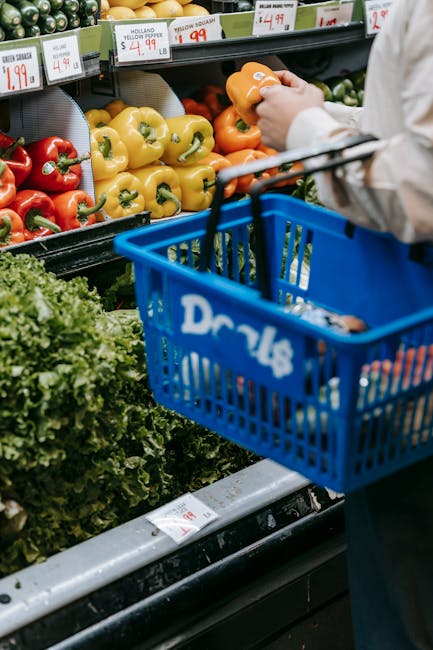Welcome to the wild world of economics, where supply and demand reign supreme! Just like a well-oiled machine, these two forces work together to determine everything from the price of your morning latte to the cost of a new car. So buckle up, because we’re about to break down the essentials of supply and demand in a way that even your grandma can understand. Get ready to dive into the world of invisible hands and elasticity like never before!
Understanding the Basics of Supply and Demand
So, you want to understand the basics of supply and demand, eh? Well, you’ve come to the right place! Let me break it down for you in a way that even your grandma would understand. Supply and demand is like the yin and yang of the economics world – they’re two peas in a pod, two sides of the same coin, two… well, you get the idea.
First things first, let’s talk about supply. Supply is basically the amount of a good or service that producers are willing and able to sell at a given price. It’s like that friend who always has extra concert tickets to sell – they’ll keep selling them until everyone has one, and then the price might just go up. It’s all about that law of supply: as prices go up, producers are more willing to supply goods and services.
Now, onto demand. Demand is the flip side of the coin – it’s the quantity of a good or service that consumers are willing and able to buy at a given price. It’s like those trendy sneakers everyone is dying to get their hands on – the demand is high, so the price goes up. And just like the law of supply, the law of demand states that as prices go down, consumers are more willing to buy goods and services.
So, there you have it – the basics of supply and demand in a nutshell. Remember, it’s all about finding that sweet spot where supply meets demand, like peanut butter and jelly or Batman and Robin. Keep these principles in mind, and you’ll be a regular economics guru in no time!

Factors Influencing Supply
When it comes to supply, there are several factors that can influence how much of a product is produced and brought to market.
One key factor is cost of production. If it’s cheaper for a company to produce a product, they’re more likely to supply more of it. But if costs skyrocket (looking at you, fluctuating oil prices), supply may dwindle faster than a procrastinator’s motivation to study for a test.
Another factor to consider is technology. Advances in technology can lead to more efficient production methods, making it easier for companies to ramp up supply. Just think about how 3D printing has changed the game for custom manufacturing. Talk about a supply chain revolution!
Don’t forget about government regulations! Whether it’s environmental restrictions or trade agreements, governments have the power to shape supply by placing limits or providing incentives. It’s like the supply world’s version of playing by the rules (or lack thereof).
Factors Influencing Demand
are like the ingredients in a recipe – they all come together to create the perfect economic dish. Let’s dig into some of the key factors that can make demand rise and fall faster than a soufflé in the oven.
First up, we have **Customer Preferences**. Just like how some people prefer mustard over mayo on their sandwich, consumers have their own unique tastes and preferences. These can be influenced by trends, advertising, or personal experiences. So if all the cool kids are suddenly into fidget spinners, you can bet demand for them will skyrocket faster than you can say “spin to win”.
Next, we’ve got **Price of Related Goods**. Think of this as a buy one, get one free deal at your favorite store. If the price of a substitute product goes down, consumers may switch over, causing demand for the original product to drop faster than a hot potato. It’s all about finding the best bang for your buck, after all.
Now, let’s talk about **Income Levels**. Just like how your wallet feels the burn after accidentally splurging on avocado toast, consumers’ purchasing power is heavily influenced by their income levels. If the economy is booming, people are more likely to splurge on luxury goods. But if times are tough, demand for those pricey items may take a nosedive faster than you can say “budget-friendly”.
In conclusion, demand is influenced by a variety of factors that can make it as unpredictable as a toddler’s tantrum. Whether it’s changing consumer preferences, the price of related goods, or income levels, the demand game is a wild ride that can make even the most seasoned economist scratch their head in bewilderment.
Finding the Equilibrium: Supply and Demand
When it comes to finding the perfect balance between supply and demand, it can feel like trying to find a unicorn in a haystack. But fear not, brave entrepreneur, for there are ways to navigate the treacherous waters of the market and emerge victorious!
First and foremost, it’s important to understand that supply and demand is a delicate dance. Too much supply and you’re drowning in excess inventory, too little and you’re left high and dry with disappointed customers. So how do you find that sweet spot? Here are a few tips to help you along the way:
- Stay informed: Keep your finger on the pulse of the market. Know what your competitors are up to and be aware of any potential changes in consumer behavior.
- Adjust accordingly: Don’t be afraid to tweak your supply and demand strategy as needed. If sales are booming, ramp up production. If things are slowing down, consider cutting back to avoid a surplus.
Remember, finding equilibrium is an ongoing process. It may take some trial and error, but with a bit of creativity and a lot of determination, you’ll be well on your way to mastering the art of supply and demand!

Price Elasticity and its Impact on Supply and Demand
So, you want to know about price elasticity, huh? Well, buckle up because we’re about to dive into this wild world where supply and demand are constantly duking it out like two toddlers fighting over the last cookie.
Picture this: a world where prices are like elastic bands – stretch them too far and they snap back, but keep them too loose and everything falls apart. That’s price elasticity for you. When prices go up, demand goes down faster than a toddler running away from a bath. But when prices drop, suddenly everyone wants a piece of the pie (or cookie, whichever you prefer).
In the grand dance of supply and demand, price elasticity plays the role of the peacemaker – keeping things in balance and ensuring that neither side gets too cocky. It’s like that one friend who always knows how to diffuse a tense situation and bring harmony back to the group.
Remember, folks, in the world of economics, price elasticity is king. So next time you see prices rising faster than a loaf of bread in a baking competition, just remember the magical powers of supply and demand – and how price elasticity keeps everything in check. Who knew economics could be so entertaining, right?
Market Equilibrium and its Significance in Economics
In the world of economics, market equilibrium is like the holy grail – the point where supply and demand meet, with everyone holding hands and singing Kumbaya. It’s the ultimate balancing act, ensuring that prices are just right and no one is left feeling cheated or overpriced.
Market equilibrium is like the Goldilocks principle of economics – not too hot, not too cold, but just right. It’s that sweet spot where buyers and sellers are perfectly content, like a match made in economic heaven. When equilibrium is achieved, there’s harmony in the market, like a well-orchestrated symphony with supply and demand playing in perfect unison.
Without market equilibrium, chaos would ensue – prices would be all over the place, causing confusion and headaches for everyone involved. It’s like a game of economic Jenga, with one wrong move threatening to bring down the entire market tower. Thankfully, market equilibrium keeps everything in check, preventing a financial free-for-all.
So next time you’re feeling overwhelmed by the complexities of economics, just remember the magic of market equilibrium. It’s the glue that holds the economic universe together, ensuring that everyone gets their slice of the economic pie. And who doesn’t love pie?
FAQs
What causes shifts in supply and demand?
Well, imagine supply and demand are at a party. When something exciting (like a new technology or a shortage of resources) happens, they start moving around, causing shifts. It’s like musical chairs, but with goods and services.
How do price ceilings and price floors affect supply and demand?
Price ceilings are like the strict parents at the party who won’t let you spend more than a certain amount. Price floors, on the other hand, are like your best friend who always encourages you to spend more. These policies can either limit or increase the amount of goods and services available, making supply and demand do a little dance.
What role do substitutes and complements play in supply and demand?
Substitutes are like the backup dancers to the main act – when the price of one good goes up, people might switch to a cheaper substitute. Complements, on the other hand, are like peanut butter and jelly – they go hand in hand, and if the price of one goes up, demand for the other might go down. It’s all about finding the perfect balance.
How do external factors impact supply and demand?
External factors are like the unexpected guests who show up to the party – they can really shake things up. Natural disasters, government policies, and even social trends can all affect supply and demand in surprising ways. It’s like playing a game of economics roulette!
—
In Conclusion: Supply, Demand, and the Rollercoaster of Economics
In the wacky world of economics, supply and demand reign supreme. Remember, it’s all about finding that delicate balance between what people want and what you can give them (without bankrupting yourself in the process). So, the next time you’re struggling to understand the ins and outs of the market, just remember: it’s all about the basics, baby. Supply and demand, the ultimate power couple of the economic world.






